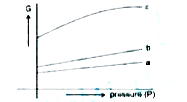For a perfectly cyrstalline solid Cp,m=aT3+bT, where a and b are constants. If Cp,m is 0.40 J/K mol at 10K and 0.92 J/K mol at 20K, then molar entropy at 20K is 0.2x×R joules. Then the value of x isSolution in Telugu
The correct Answer is:5 J/K mol
Step by step video, text & image solution for For a perfectly cyrstalline solid C_(p,m)= a T^(3) + bT, where a and b are constants. If C_(p,m) is 0.40 J/K mol at 10K and 0.92 J/K mol at 20K, then molar entropy at 20K is 0.2x xx R joules. Then the value of x is by Chemistry experts to help you in doubts & scoring excellent marks in Class 12 exams.
Updated on:21/07/2023Topper's Solved these Questions
- CHEMICAL THERMODYNAMICSBOOK - AAKASH SERIESCHAPTER - CHEMICAL THERMODYNAMICSEXERCISE - Additional Practice Exercise
54 Videos
- CHEMICAL THERMODYNAMICSBOOK - AAKASH SERIESCHAPTER - CHEMICAL THERMODYNAMICSEXERCISE - Practice Sheet- Exercise-III
30 Videos
- CHEMICAL KINETICSBOOK - AAKASH SERIESCHAPTER - CHEMICAL KINETICSEXERCISE - Objective Exercise - 4 (Assertion (A) & Reason (R) Type Questions)
44 Videos
- CHEMISTRY IN EVERY DAY LIFEBOOK - AAKASH SERIESCHAPTER - CHEMISTRY IN EVERY DAY LIFEEXERCISE - PRACTICE EXERCISE
29 Videos
Similar Questions
Which among the following is not an exact differential?
View SolutionThe following curve represents the variation of Gibbs function 'G' with pressure at constant temperature. Correct match of given plots with the physical state of a substance is

View Solution(A) Spontaneous reaction may be slow or fast.
(R ) Spontaneous nature deals with feasibility of the reaction but not rate.
View SolutionAnti allergy drugs are
View SolutionThe molar internal enegry of a gas over a temperature range is expressed as: U_(m) (T) =a +bT +cT^(2) , where b = 16 J mol^(-1)K^(-1) and c = 6 xx 10^(-3) J mol^(-1)K^(-2) . Find: a. C_(V,m)at 300K b. The entropy change when 1 mol of a gas is heated from 300K to 600K at constant volume.
View SolutionFor a perfectly crystalline solid Cp.m.=aT3, where ais constant. If Cp.m. is 0.42.J//K-"mol" at 10K, molar entropy at 10K is:
View SolutionFor a perfectly crystalline solid Cp.m.=aT3+bT,where a and b constant . If Cp.m.is0.40J/Kmol at 10K and 0.92J/Kmolat20K then molar entropy at 20k is:
View SolutionFor a perfectly crystalline solid C_(p,m)=aT^(3)+bT , where a and b are constant. If C_(p,m) is 0.40 J/K mol at 10 K and 0.92 J/K mol at 20 K, then molar entropy at 20 K is :
View SolutionFor a perfectly crystalline solid C_("p,m") =T^(3)+bT , where a & b are constant . If C_("p,m") is 0.04 J//k-"mole" at 10 K and io 0.92 J//K-"mole" at 20 k, Then molar entropy at 20 k is.
View SolutionFor a perfectly crystaline solid C_(p.m)=aT^(3) , where a is constant. If C_(p.m) is 0.42J//K-mol at 10 K , molar entropy at 10 K is:
View SolutionGreenhouse gas CO_(2) can be converted to CO(g) by the following reaction CO_(2)(g)+H_(2)(g) rarr CO_(2)+H_(2)O(g) , termed as water gas reaction. Calculate DeltaH at 1400 K using the given data for 1000K , assuming the C_(p)^(@) values remain constant in the given temoerature range. DeltaH=35040 J"mol"^(-1), C_(p)^(@)(CO_(2))=(42.31 + 10.09 xx 1^(-3)T) J "mol"^(-1)K_(1) C_(P)^(@)(H_(2))=(27.40 + 3.20 xx 10^(-3)T) J"mol"^(-1)K_(1) C_(P)^(@)(CO)=(28.34+ 4.14 xx 10^(-3)T)J"mol"^(-1)K^(-1) C_(P)^(@)(H_(2)O)=(30.09 + 10.67 xx 10^(-3)T)J"mol^(-1)K^(-1)
View SolutionFor the given reaction ,
A(g)→2B(g),ΔrH=30kJ/moleΔrS=150J/mol at 300K
If CP,A=20J/Kmol and CP,B=20J/Kmol.(ln3/2=0.4)
Which of the following statement is/are correct ?
View SolutionThe ratio of specific heats of a gas is 1.4. if the value of C_(V) is 20.8 J/mol K, then the C_(P) is
View SolutionFor a perfectly crystalline solid Cp.m=aT3, where a is constant. If Cp.m is 0.42 J/K − mol at 10K, molar entropy at 10K is
View SolutionFor a perfectly cyrstalline solid Cp,m=aT3+bT, where a and b are constants. If Cp,m is 0.40 J/K mol at 10K and 0.92 J/K mol at 20K, then molar entropy at 20K is 0.2x×R joules. Then the value of x is
View Solution
